

The
Research Project
The Study Area
Background Information
Tools Of The Trade
A Day In The Life Of . . .
Thursday, December 6, 2001
Walking As Silently As A Forest Elephant
The Ghanaian people say that the only way you know a forest elephant is beside you is when you hear its stomach growl. We have yet to master the art of walking silently "like a forest elephant" but we are trying. No doubt we are going to have lots of practice.
Yesterday afternoon was our first official monkey survey. We all piled into the truck at 3:30 and drove to the trail head. Lindsay always makes certain that she spaces surveys that take place on the same trail at least two days apart. That way she gives the animals time to come back into the area if her presence has scared them away.
While doing the surveys we must be as quiet as possible. Once we start, single file down the trail, we can no longer talk to each other. We also walk as slowly as possible so that our footsteps are not heard. Our mantra becomes, "First place the boot toe, slowly roll the foot back to place the heel, lean forward while picking up the front boot and place the toe of the other boot ahead, slowly roll back to place the heel...repeat 10,000 times." It took us 2 hours to walk 1.2 kilometers (about 3/4 of mile)!
Try walking outside on leaves and twigs without making a sound. How slowly do you have to move in order to be silent? For Lindsay and her guides, walking silently comes naturally. For us, the minute we looked up or started to daydream, one of our boots would come crashing down on something noisy. We also have to be mindful of the clothing we wear on the transects. No bright colors or we will be seen too easily by the monkeys.
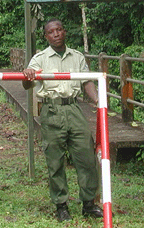 Lindsay
always walks her transects with a guard. Samuel (pronounced Samwell) would
stop periodically - poised as gracefully as a dancer - to listen to the
forest. What was indistinguishable jungle noise to us were the calls of
distinct animals—most of which Samuel knew by name.
Lindsay
always walks her transects with a guard. Samuel (pronounced Samwell) would
stop periodically - poised as gracefully as a dancer - to listen to the
forest. What was indistinguishable jungle noise to us were the calls of
distinct animals—most of which Samuel knew by name.
The reason that Lindsay travels with a guard is that the forest often is used by poachers and frequented by elephants. Poachers are hunters who take plants and animals from protected areas illegally and they often carry guns. Samuel's job is to protect Lindsay from such dangers and to capture any poachers they see while walking their transects.
Poaching is taken very seriously by the wildlife employees we have met. Men like Samuel understand how important it is to protect the plants and animals in the reserve. Many of the locals do not know the importance of the animals to the forest or the implications of heavy hunting. In addition, Ghanaians depend on the forest for many building materials and other "non-timber forest products" like chewing sticks and pestles to pound fufu. These things are often taken illegally from protected areas.
Additionally many Ghanaians prefer the "bush meat" or meat from jungle animals to ordinary livestock like goats and cows. Ghanaians eat everything from rats to monkeys to elephants. Luckily, we haven't seen any poachers so far although one was captured only last Friday in the area.
While we walked ever so slowly we were listening for the call of the Roloways. That is the one of the best ways to find them as they often live high up in the canopy. Sometimes they are found because the White-crested hornbill bird often travels with Roloways. Fortunately when these hornbills travel with the monkeys they are very noisy. Whenever we heard one we knew there was a good chance the monkeys were nearby. Of course Lindsay can't record anything in her log book unless she actually sees or hears the monkeys and even then, she has to positively identify them.
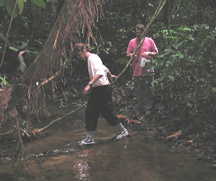 The
trail was covered in detritus (decaying matter) from the forest above. Numerous
times we had to climb over and around trees and vines and we crossed over
or through many streams. We even had to walk tightrope style on a tree that
had fallen across a steam to continue on the trail.
The
trail was covered in detritus (decaying matter) from the forest above. Numerous
times we had to climb over and around trees and vines and we crossed over
or through many streams. We even had to walk tightrope style on a tree that
had fallen across a steam to continue on the trail.
From time to time, it would rain. We could hear lightening and thunder and the sound of raindrops falling on the canopy above, yet we never got drenched. Instead, the canopy acts like a million umbrellas. Rain falling on the forest canopy falls through layers and layers of trees and by the time it reaches the ground it is just a constant dripping as if every leaf were crying. The rain came and went but the dripping never stopped, resulting in all the plants being wet all the time.
As twilight set in we stopped for a long time to wait for any monkeys that might be in the area to start calling to one another. There is always a constant cacophony of sound in the forest but as the forest moves into darkness the sound changes as the diurnal or day animals settle in for the night and the nocturnal or night animals become active. During our survey we heard an African palm civet. Unfortunately we never did hear any Roloways.
Walking back in the complete darkness with just a flashlight was challenging. Samuel and Lindsay moved quickly being use to such travel. The rest of us stumbled and tripped and followed along as best we could. The last thing we wanted was to lose track of their head lamps on the trail ahead.
After our survey we traveled to Elubo for a bite to eat at a roadside food stand and cool drinks. Standing among a crowd of people, Lindsay helped us order from the selection of food laid out on the table. We chose beans, rice, fresh cabbage with onions—all covered with spicy chili sauce. Kevin and Mike wanted to buy some roasted meat from another nearby food stand. They discovered just in time that what they thought were skewers of roasted chicken were not. Just before they bit into their skewers, the man selling the meat demonstrated to them how to eat them. He bit the end of the meat and pulled with his teeth while Kevin and Mike watched in horror as the meat unraveled from the skewer into a long thin piece of animal intestine. They ended up eating beans and rice with the rest of us.
Going To Town
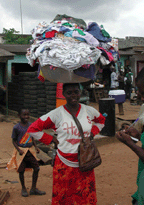
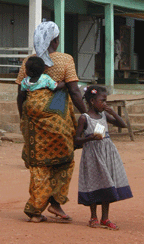 One
of the most amazing sites we see every day as we travel down the roads is
the site of people carrying a multitude of things on their heads. The women
have amazing balance. They can balance baskets or bundles of wood, food,
and clothing while carrying a baby on their back as well.
One
of the most amazing sites we see every day as we travel down the roads is
the site of people carrying a multitude of things on their heads. The women
have amazing balance. They can balance baskets or bundles of wood, food,
and clothing while carrying a baby on their back as well. 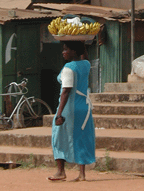
We watched one mother as she prepared to carry her baby. She first bent over and put the baby on her back like she was giving it a piggy back ride. She then tied a colorful cloth around her back to secure the baby. The cloth was wrapped and then secured in the front at the mother's waist. The mother was careful to tuck in the baby's legs and arms. Lastly, another colorful cloth is wrapped around like a sarong covering the mother's legs.
Children in Ghana
While walking through the local town, we saw many children on their way to and from school. School is not free in Ghana—going to school is a privilege and costs money. One year of schooling costs the equivalent of $250.00 US dollars or more. This is very expensive if a family has more than one child. For example, wildlife guards make less than $500.00 a year.
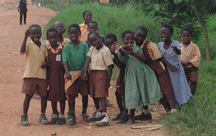
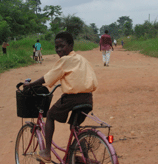 The
school uniform is an orange shirt and brown shorts, pants, or skirts. They
are similar to uniforms children in the United States wear. Many of the
students wear backpacks to carry their books and lunch. Some of the students
ride bicycles to school.
The
school uniform is an orange shirt and brown shorts, pants, or skirts. They
are similar to uniforms children in the United States wear. Many of the
students wear backpacks to carry their books and lunch. Some of the students
ride bicycles to school.
We met one woman, Miriam, who was looking at the schoolwork of her son. The work looked just like the papers that we give to our students. Miriam's son was very good in math, but needed to work on his history.
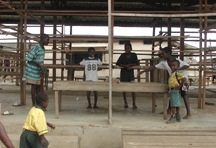 Children
in Ghana play many of the same games that we see children in the United
States play. We saw children playing ping pong in the town. They used shells
and a pole to make the net. Michael played with them for a few serves.
Children
in Ghana play many of the same games that we see children in the United
States play. We saw children playing ping pong in the town. They used shells
and a pole to make the net. Michael played with them for a few serves. 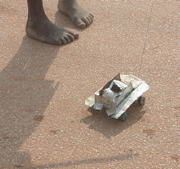 The
children also play a lot of "football", or what we know as American soccer.
Girls play a game called Ampe, which is like rock, paper, scissors but instead
of using their hands, they jump and clap. It is pretty hard to pick up,
but we laughed a lot trying.
The
children also play a lot of "football", or what we know as American soccer.
Girls play a game called Ampe, which is like rock, paper, scissors but instead
of using their hands, they jump and clap. It is pretty hard to pick up,
but we laughed a lot trying.
Toys are hard to find in the towns so children make their own. Boys use old Milo (hot chocolate powder) cans to make trucks. They also make lorries or trucks out of bamboo poles, with old flip flop bottoms serving as tires. Girls use sugar cane and fray the ends to make dolls. Both boys and girl roll old wheels with sticks and chase them along the road.